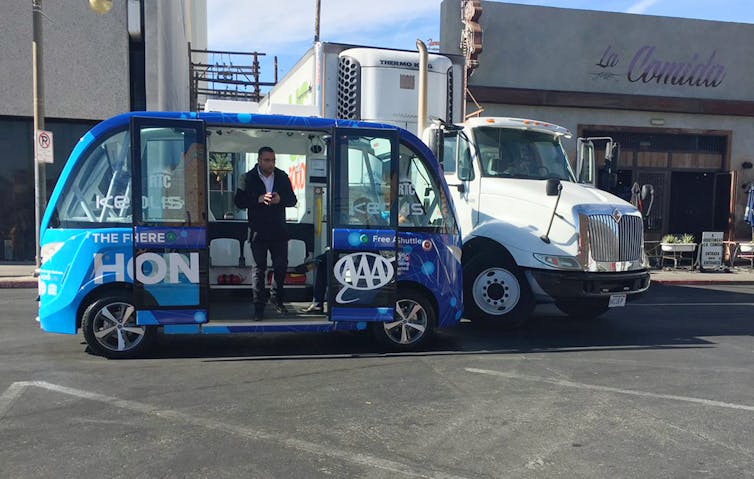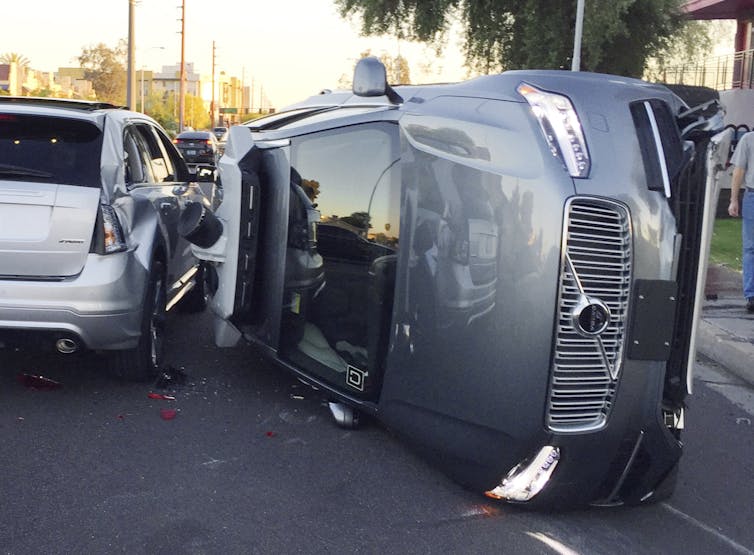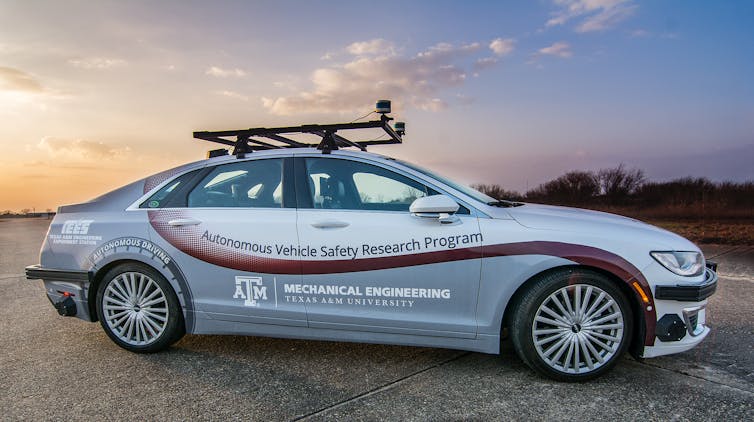In early November, a self-driving shuttle and a supply truck collided in Las Vegas. The occasion, during which nobody was injured and no property was severely broken, attracted media and public consideration partially as a result of one of many autos was driving itself – and since that shuttle had been working for under lower than an hour earlier than the crash.
It’s not the primary collision involving a self-driving automobile. Different crashes have concerned Ubers in Arizona, a Tesla in “autopilot” mode in Florida and a number of others in California. However in almost each case, it was human error, not the self-driving automobile, that triggered the issue.
In Las Vegas, the self-driving shuttle seen a truck up forward was backing up, and stopped and waited for it to get out of the shuttle’s method. However the human truck driver didn’t see the shuttle, and stored backing up. Because the truck bought nearer, the shuttle didn’t transfer – ahead or again – so the truck grazed the shuttle’s entrance bumper.
As a researcher engaged on autonomous methods for the previous decade, I discover that this occasion raises numerous questions: Why didn’t the shuttle honk, or again as much as keep away from the approaching truck? Was stopping and never shifting the most secure process? If self-driving vehicles are to make the roads safer, the larger query is: What ought to these autos do to cut back mishaps? In my lab, we’re growing self-driving vehicles and shuttles. We’d like to unravel the underlying security problem: Even when autonomous autos are doing all the pieces they’re purported to, the drivers of close by vehicles and vehicles are nonetheless flawed, error-prone people.

Kathleen Jacob/KVVU-TV by way of AP
How crashes occur
There are two fundamental causes for crashes involving autonomous autos. The primary supply of issues is when the sensors don’t detect what’s taking place across the automobile. Every sensor has its quirks: GPS works solely with a transparent view of the sky; cameras work with sufficient mild; lidar can’t work in fog; and radar shouldn’t be notably correct. There will not be one other sensor with completely different capabilities to take over. It’s not clear what the best set of sensors is for an autonomous automobile – and, with each value and computing energy as limiting components, the answer can’t be simply including increasingly more.
The second main drawback occurs when the automobile encounters a state of affairs that the individuals who wrote its software program didn’t plan for – like having a truck driver not see the shuttle and again up into it. Similar to human drivers, self-driving methods must make tons of of choices each second, adjusting for brand new data coming in from the setting. When a self-driving automobile experiences one thing it’s not programmed to deal with, it usually stops or pulls over to the roadside and waits for the state of affairs to alter. The shuttle in Las Vegas was presumably ready for the truck to get out of the way in which earlier than continuing – however the truck stored getting nearer. The shuttle might not have been programmed to honk or again up in conditions like that – or might not have had room to again up.
The problem for designers and programmers is combining the knowledge from all of the sensors to create an correct illustration – a computerized mannequin – of the area across the automobile. Then the software program can interpret the illustration to assist the automobile navigate and work together with no matter is perhaps taking place close by. If the system’s notion isn’t ok, the automobile can’t make a very good determination. The principle reason behind the deadly Tesla crash was that the automobile’s sensors couldn’t inform the distinction between the brilliant sky and a big white truck crossing in entrance of the automobile.
If autonomous autos are to meet people’ expectations of decreasing crashes, it received’t be sufficient for them to drive safely. They need to even be the last word defensive driver, able to react when others close by drive unsafely. An Uber crash in Tempe, Arizona, in March 2017 is an instance of this.

Tempe Police Division by way of AP
In accordance with media stories, in that incident, a particular person in a Honda CRV was driving on a serious highway close to the middle of Tempe. She wished to show left, throughout three lanes of oncoming visitors. She might see two of the three lanes have been clogged with visitors and never shifting. She couldn’t see the farthest lane from her, during which an Uber was driving autonomously at 38 mph in a 40 mph zone. The Honda driver made the left flip and hit the Uber automobile because it entered the intersection.
A human driver within the Uber automobile approaching an intersection might need anticipated vehicles to be turning throughout its lane. An individual might need seen she couldn’t see if that was taking place and slowed down, maybe avoiding the crash solely. An autonomous automobile that’s safer than people would have executed the identical – however the Uber wasn’t programmed to.
Enhancing testing
That Tempe crash and the newer Las Vegas one are each examples of a automobile not understanding the state of affairs sufficient to find out the right motion. The autos have been following the foundations they’d been given, however they weren’t ensuring their choices have been the most secure ones. That is primarily due to the way in which most autonomous autos are examined.
The fundamental customary, after all, is whether or not self-driving vehicles can observe the foundations of the highway, obeying visitors lights and indicators, realizing native legal guidelines about signaling lane adjustments, and in any other case behaving like a law-abiding driver. However that’s solely the start.

Swaroopa Saripalli, CC BY-ND
Earlier than autonomous autos can actually hit the highway, they should be programmed with directions about easy methods to behave when different autos do one thing out of the atypical. Testers want to contemplate different autos as adversaries, and develop plans for excessive conditions. As an example, what ought to a automobile do if a truck is driving within the improper path? In the mean time, self-driving vehicles may attempt to change lanes, however might find yourself stopping useless and ready for the state of affairs to enhance. In fact, no human driver would do that: An individual would take evasive motion, even when it meant breaking a rule of the highway, like switching lanes with out signaling, driving onto the shoulder and even dashing as much as keep away from a crash.
Self-driving vehicles should be taught to grasp not solely what the environment are however the context: A automobile approaching from the entrance shouldn’t be a hazard if it’s within the different lane, but when it’s within the automobile’s personal lane circumstances are solely completely different. Automotive designers ought to take a look at autos based mostly on how effectively they carry out troublesome duties, like parking in a crowded lot or altering lanes in a piece zone. This will likely sound lots like giving a human a driving take a look at – and that’s precisely what it needs to be, if self-driving vehicles and individuals are to coexist safely on the roads.

